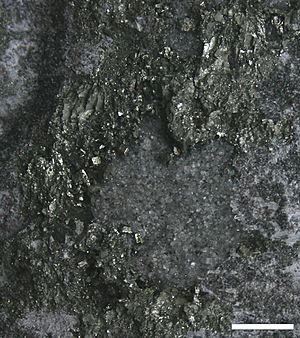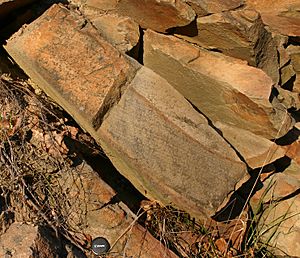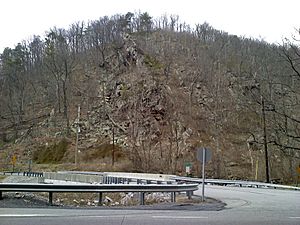Bald Eagle Formation facts for kids
Quick facts for kids Bald Eagle FormationStratigraphic range: Late Ordovician |
|
|---|---|

|
|
| Type | sedimentary |
| Underlies | Juniata Formation |
| Overlies | Reedsville Formation |
| Thickness | 275 +/-25 m |
| Lithology | |
| Primary | sandstone |
| Other | conglomerate, shale |
| Location | |
| Region | Appalachian Mountains |
| Extent | Pennsylvania, Maryland, West Virginia |
| Type section | |
| Named for | Bald Eagle Mountain, Pennsylvania |
| Named by | A. W. Grabau |
The Bald Eagle Formation is a type of rock found in central Pennsylvania, USA. It formed a very long time ago, during the Ordovician period. This rock unit often creates tall ridges in the Appalachian Mountains.
Contents
What is the Bald Eagle Formation?
The Bald Eagle Formation is mostly made of a rock called sandstone. It can be gray, olive-gray, or reddish-gray. The sand grains in it can be fine (like beach sand) or coarse (like tiny pebbles).
Sometimes, you can see special patterns in the rock called crossbedding. This means the layers of sand were laid down at an angle, often by moving water or wind. In some places, the formation also contains a rock called conglomerate. This rock is made of larger, rounded pebbles cemented together.
How Did These Rocks Form?
Scientists believe the Bald Eagle Formation rocks were created on land or in shallow seas. They formed from sediments that washed down from ancient mountains. These mountains were created during a huge event called the Taconic orogeny, which was a time when continents collided.
What Fossils Are Found Here?
It's rare to find many fossils in the Bald Eagle Formation. Most of the fossils found are trace fossils. These are not parts of ancient animals, but rather signs of their activity. For example, they might be fossilized tracks, trails, or burrows.
However, at the very bottom of the formation, there's a special layer. This layer contains many Orthorynchula brachiopods. Brachiopods are ancient marine animals with two shells, similar to clams.
How Old is the Bald Eagle Formation?
The Bald Eagle Formation is part of the Upper Ordovician period. This means it formed between 488.3 and 443.7 million years ago. Imagine how old that is! It sits on top of the Reedsville Formation and below the Juniata Formation.
What is the Bald Eagle Formation Used For?

The rocks from the Bald Eagle Formation are useful for several things. They are often used as material for building roads. They can also be used as riprap, which are large, broken rocks used to protect shorelines or slopes from erosion. Sometimes, they are even used as building stone.
However, there's a small problem. The rock can sometimes contain iron pyrite. Pyrite is also known as "fool's gold." When pyrite is exposed to air and water, it can create acidic runoff. This means rainwater flowing over the rocks might become slightly acidic.
Images for kids




